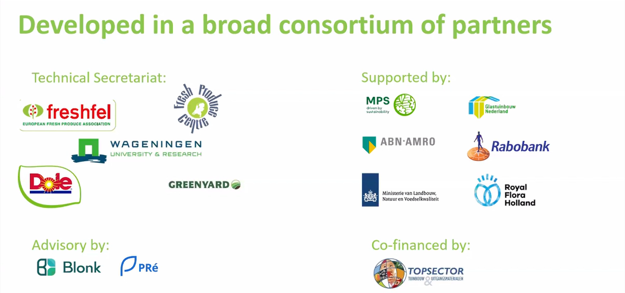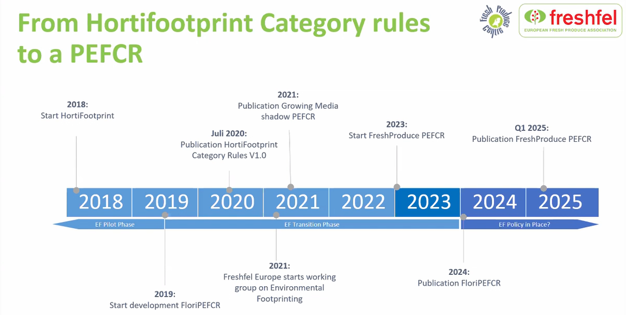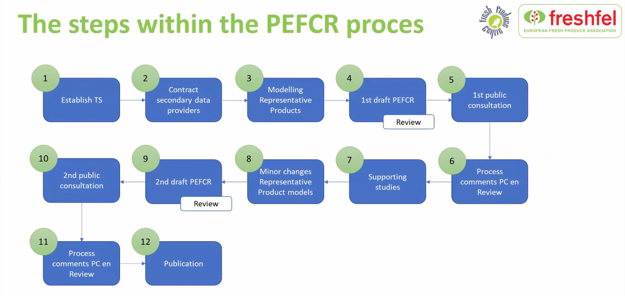On March 26, Freshfel Europe unveiled its research on Product Environmental Footprint Category Rules (PEFCR) for fruits and vegetables. Gil Kaufman and Philippe Binard (Freshfel Europe), Nikki Hulzebos (Groentenfruithuis), and Jeroen Weststrate (Wageningen Research) provided attendees with an overview of PEFCR in general and its benefits when applied to the fruit and vegetable sector.
"The environmental impact of products has gained increasing attention due to supply chain requirements, legal sustainability demands, consumers seeking trustworthy information, non-governmental organizations demanding transparency, and a general rise in demand for transparency from producers, producer associations, and trading companies. This has led to individual companies calculating the ecological footprint of their products, which is great in itself. However, this results in a fragmentation of efforts within the sector, achieving the opposite of what we want, namely an increase in environmental certifications, claims, initiatives, and labels," said Gil Kaufman at the beginning of the presentation.
Product Environmental Footprint (PEF)
"Using a uniform and reliable methodology across the entire sector would ensure that the calculations of the ecological footprint and the subsequent sustainability statements are comparable, verifiable, and reproducible. The EU Commission has developed the Product Environmental Footprint (PEF) method, a life cycle analysis (LCA) based method. It considers the environmental impacts of a product unit from the extraction of raw materials to waste disposal ("Cradle-to-Grave approach") and is recommended by the Commission as a method for measuring and communicating the environmental performance of products (and organizations) throughout their entire lifecycle." Furthermore, it is related to several EU policy initiatives (Green-Claims Directive, revision of the Directive on unfair commercial practices to ban unfounded sustainability labels and claims, proposal for a legal framework for sustainable food systems, including sustainability labeling of food). The goal is the "development of a harmonized methodology for calculating the ecological footprint of products and organizations".

Product Environmental Footprint Category Rules (PEFCR)
"PEFCR aim to address the problem of increasing methods for calculating the environmental footprint or environmental statements, labels, and initiatives. PEFCR are reproducible, comparable, and verifiable, which prevents market confusion and mistrust, enables easier comparison between products of the same product category, and enhances transparency both in the supply chain and for consumers regarding the sustainability of products."
"The benefits of developing PEFCR for the fruit and vegetable sector are that PEFCR is the (most likely) most credible and transparent method to determine the ecological footprint of products currently on the market and to promote trust in product sustainability in B2B and B2C communication. Moreover, it enables comparison between products within a product category as well as the identification of hotspots and options for reducing the ecological footprint in the product lifecycle. Furthermore, it ensures compliance with future EU legislation and helps companies to prepare for upcoming requirements for non-financial reporting at the corporate level. The challenges lie in the complex methodology, which requires a large amount of data and LCA expertise as well as investments from the sector (also financially) and commitment," Kaufman continued.
"In return, you get a method that not only facilitates the obligation to sustainability reporting but also supports operational sustainability reporting at the company and sector level. It assists the sector in justifying relevant operational decisions, such as in the choice of packaging, logistics decisions, energy consumption, the identification of hotspots for emission reduction, Green Claims, and compliance with EU legislation."

FreshProducePEFCR
The goal was to develop an "objective, standardized environmental footprint method, database, and digital tool for the fresh sector, which would be broadly accepted by the industry, stakeholders, and consumers." Since 2019, there have been discussions in Freshfel about the ecological footprint in relation to sustainability labeling. In March 2021, Freshfel launched the Environmental Footprint Initiative. Now, they are ready to publish a formal revision of the existing HortiFootprint category rules with "shadow PEFCR" (2023-Q1 2025), which was developed together with Wageningen University Research to be connected with the European Commission's program as soon as it starts. Alongside Freshfel Europe as management and industry representation, initiative members with voluntary active participation include, for example, ailimpo, bama, Bayer, Dole, Interfel, and Zespri. Supporting organizations with advisory participation are essa and Growing Media Europe.
How are the PEFCR developed?
The development of the PEFCR involves a mix of industry knowledge and scientific/LCA experts in bi-weekly meetings with Freshfel Europe, Wageningen University Research, and Fresh Produce Centre. The technical secretariat consists of Freshfel Europe, Fresh Produce Centre, Wageningen University Research, PRé Sustainability, Blonk Sustainability, Greenyard, and Dole. Consortium members include Royal FloraHolland, ABN AMRO Bank, Rabobank, MPS, AQS Holding, Glastuinbouw Nederland. The external review team includes the National Institute for Public Health and the Environment (LCA expert), Doff Consulting (sector expert), Milieu Centraal (NGO).

The EU prescribes fixed steps within the PEFCR process, from establishing a technical secretariat to modeling representative products, drafts, public consultations, and supporting studies, leading to publication. In total, twelve steps must be completed. "As shadow PEFCR, we try to stay as close as possible to the formal steps prescribed by the EU," said Nikki Hulzebos. "We are moving towards step 5, where we ask all listeners to give us feedback on what we have published so far."
In part 2, Jeroen Weststrate from Wageningen University Research will report on the research findings for the development of the FreshProducePEFCR, which are now publicly available for consultation.
For more information:
https://freshfel.org/
